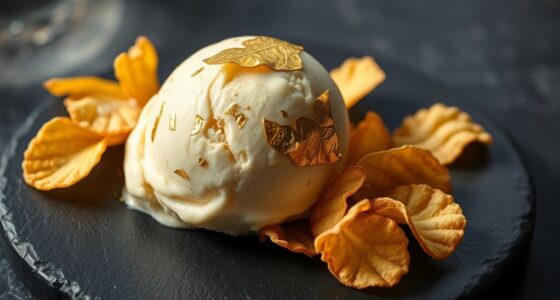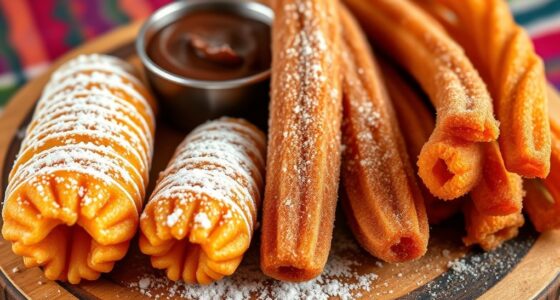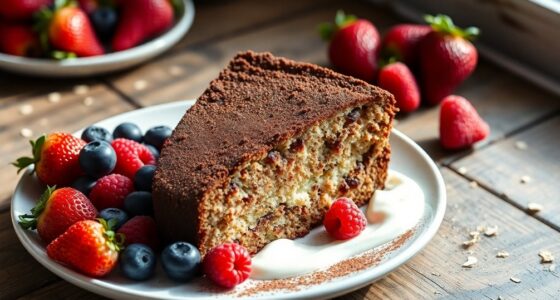In molecular gastronomy, spherified fruits turn ordinary ingredients into stunning edible spheres that burst with flavor, transforming your desserts into artful creations. Using a chemical reaction between sodium alginate and calcium, you can craft smooth, delicate spheres from your favorite fruits like strawberries or mangoes. Precise technique and the right ingredients produce impressive textures and vibrant presentations. Keep exploring to discover tips, tricks, and creative ideas to elevate your dessert game with spherified fruits.
Key Takeaways
- Spherification uses sodium alginate and calcium ions to create gelled fruit spheres with a liquid center.
- Suitable fruits include strawberries, mangoes, and kiwi, chosen for their firmness and high water content.
- Precise control of ingredients, temperature, and timing ensures consistent sphere size and texture.
- Creative flavor pairings and artistic presentation enhance visual appeal and sensory experience.
- Troubleshooting involves adjusting calcium levels and gentle handling to prevent bubbles and surface defects.
The Science Behind Spherification
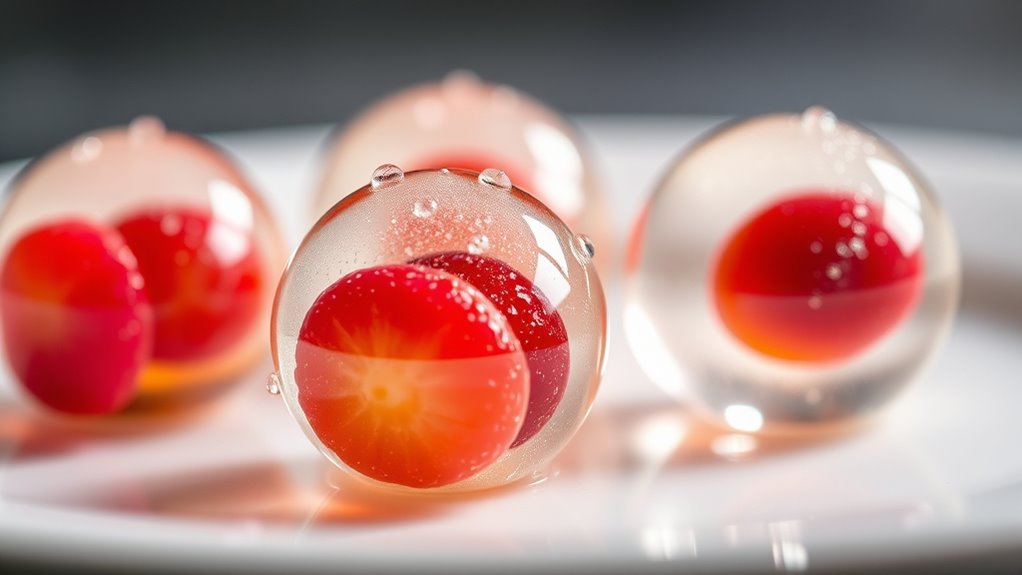
Spherification is a fascinating technique that transforms liquids into gel-like spheres, mimicking the appearance and texture of caviar or pearls. At its core, it relies on a chemical reaction between sodium alginate and calcium ions. When you introduce a flavored liquid containing sodium alginate into a calcium-rich bath, calcium ions cause the alginate to gel instantly on contact. This creates a thin, flexible membrane that traps the liquid inside, forming a sphere. The process is driven by diffusion: calcium ions move into the alginate solution, causing rapid gelation. Controlling factors like temperature, concentration, and timing allows you to create spheres with precise sizes and textures. Additionally, understanding the chemical reactions involved enables chefs to customize textures and flavors more effectively. This science-driven process results in a visually stunning and flavorful burst in your mouth. Furthermore, mastering these reaction parameters allows for consistent results and innovative culinary presentations. Proper storage of ingredients and understanding the material properties involved can also improve the success of spherification techniques. Incorporating appropriate equipment can further enhance precision and safety during the process. A thorough grasp of factors affecting gelation can help troubleshoot common issues and refine the technique.
Key Ingredients and Equipment Needed
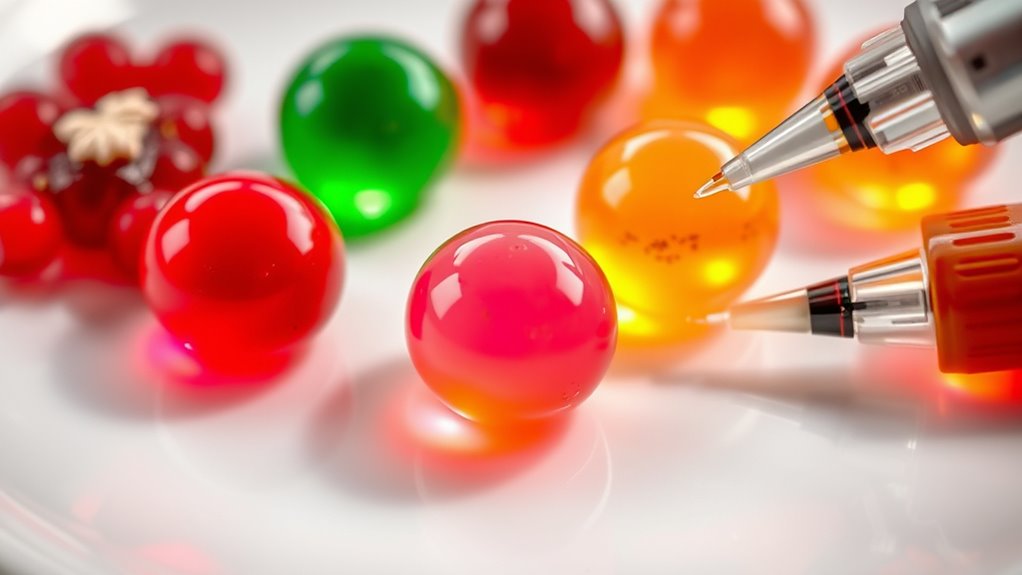
To successfully perform spherification, you’ll need specific key ingredients and equipment. The essential ingredients include sodium alginate, which forms the gel-like exterior, and calcium chloride or calcium lactate, used in the setting bath to create the sphere’s skin. You also need fresh fruit juice or puree for the liquid center. For equipment, a precision syringe or pipette helps shape the spheres accurately. A blender or immersion blender ensures smooth mixing of ingredients. A fine mesh strainer filters out lumps, and bowls or containers hold the calcium bath and fruit mixture. Additionally, a digital scale ensures precise measurements. Having these ingredients and tools ready allows you to execute spherification effectively, resulting in perfect, delicate spheres in your desserts. Mindfulness practices can also be incorporated to enhance your focus during the delicate process.
Step-by-Step Guide to Spherify Fruits
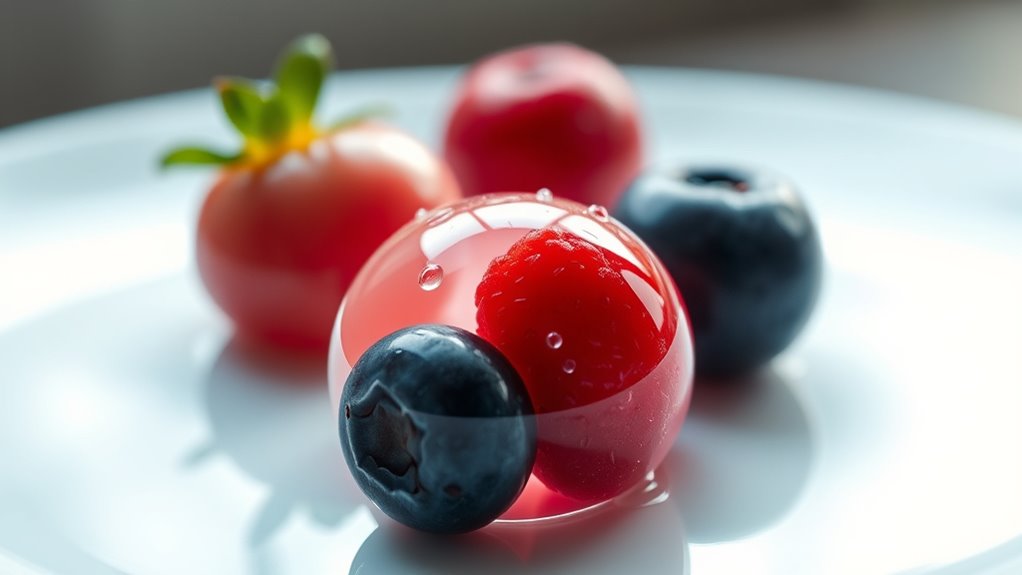
Once you’ve gathered your ingredients and equipment, you can begin transforming fresh fruits into delicate spheres. Start by preparing your fruit puree, ensuring it’s smooth and free of seeds or pulp. Measure the appropriate amount of sodium alginate and blend it into the puree until fully dissolved. In a separate bowl, mix water and calcium chloride to create the setting bath. Use a syringe or dropper to carefully release the fruit mixture into the calcium bath, forming spheres. Let them sit for about 1-2 minutes, then gently scoop out the spheres using a slotted spoon. Rinse briefly in clean water to remove excess calcium. To ensure optimal texture and flavor, proper storage techniques can help maintain their freshness and quality for serving. This process leverages heat pump technology to efficiently control temperature and preserve the spheres’ integrity. Temperature control is crucial during storage to prevent premature melting or degradation of the spheres. Using contrast ratio effectively can also enhance the visual appeal of your dessert presentation. Your fruit spheres are now ready to be served or added to desserts, offering a burst of flavor and texture.
Choosing the Right Fruits for Spherification
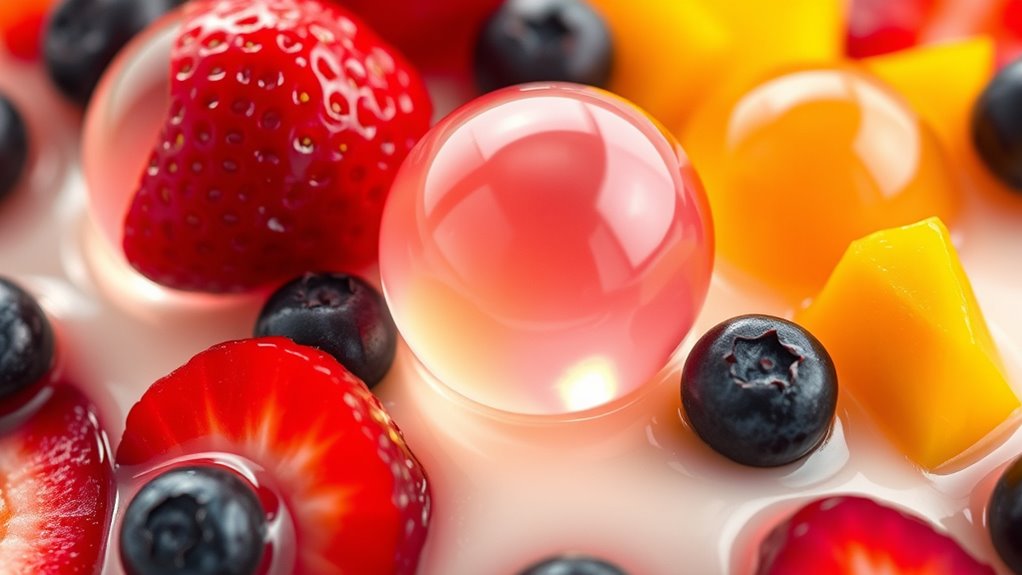
Choosing the right fruits is crucial for successful spherification because their natural properties directly affect the texture and appearance of the spheres. Fruits with firm, smooth surfaces and high water content work best, ensuring the spheres hold their shape and have a glossy finish. Avoid fruits that are overly soft, fibrous, or contain large seeds, as these can disrupt the process. Consider fruits like strawberries, mangoes, or kiwi for ideal results. To help visualize, here’s a quick comparison:
| Fruit | Key Characteristics |
|---|---|
| Strawberry | Firm, smooth surface, high water content |
| Mango | Juicy, firm flesh, minimal seeds |
| Kiwi | Slightly fuzzy, fibrous, high water |
| Banana | Soft, fibrous, low water content |
Choose fruits that match these qualities for perfect spheres. Additionally, selecting appropriate fruits can greatly influence the success of your spherification process, and understanding fruit properties is essential for achieving the desired texture. Being aware of fruit ripeness can also impact the outcome, as overripe fruits may not hold up well during the process.
Creative Flavor Combinations and Pairings
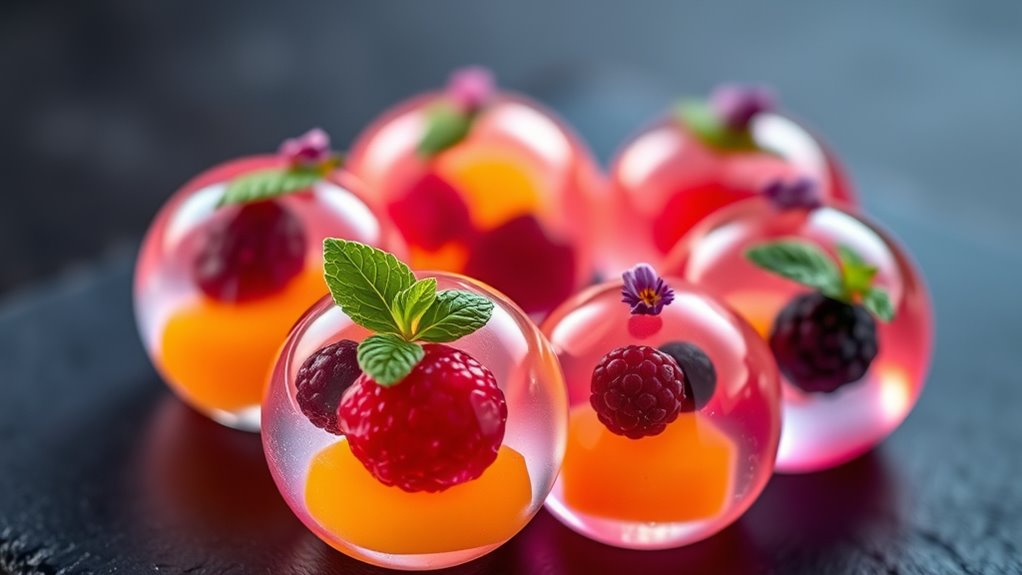
Experimenting with unconventional flavor blends can surprise your palate and elevate your dishes. By carefully harmonizing textures and tastes, you can create memorable and innovative pairings. Think beyond traditional combinations to craft unique culinary experiences. Incorporating research-supported techniques can enhance the sophistication and appeal of your dessert creations. Additionally, understanding molecular gastronomy principles allows you to manipulate ingredients in novel ways, opening up new possibilities for flavor and presentation. Exploring tea infusion methods can further refine how flavors are integrated, resulting in more complex and refined spherified fruits in desserts. Recognizing how compatibility varies among ingredients can help you develop harmonious flavor combinations that delight the senses. Employing techniques for flavor balancing is also essential to ensure that each element complements the other perfectly.
Unconventional Flavor Blends
Have you ever wondered how unexpected flavor pairings can elevate a dish to new heights? Unconventional blends surprise your palate and create memorable experiences. Think about combining savory herbs with sweet fruits or adding a touch of spice to creamy desserts. These daring combinations challenge traditional boundaries and open doors to innovation. For example, pairing balsamic vinegar with strawberries enhances their sweetness with a tangy depth. Or, mixing wasabi with melon introduces a spicy kick that excites your senses. When you experiment with these unusual blends, you push the limits of flavor harmony and reveal new potential in your culinary creations. The key is balancing contrasting elements to craft bold, harmonious profiles that delight and intrigue. Practicing mindfulness while exploring these flavor profiles can deepen your sensory awareness and creative practice can be fostered through such experimentation, ultimately enhancing your culinary artistry. Additionally, understanding the science behind molecular gastronomy can inspire more creative and precise flavor pairings that captivate your palate.
Harmonizing Textures and Tastes
Unconventional flavor pairings captivate the palate, but mastering their harmony often involves more than just blending tastes—you need to contemplate textures as well. Combining smooth, creamy spherified fruits with crisp elements creates exciting contrasts that enhance each bite. Think about balancing the richness of a custard with the lightness of a fruit foam or adding crunchy nuts to soften a silky gel. When experimenting, consider how textures interact to elevate flavors. Use the table below as a guide to create appealing pairings:
| Texture | Flavor Pairing | Effect |
|---|---|---|
| Crispy | Tangy citrus | Brightens and refreshes |
| Smooth | Sweet berry | Enhances richness |
| Chewy | Slightly bitter greens | Adds complexity |
| Light foam | Savory herbs | Balances sweetness |
| Firm gel | Spiced caramel | Creates contrast |
Presentation Tips for Stunning Dessert Platings
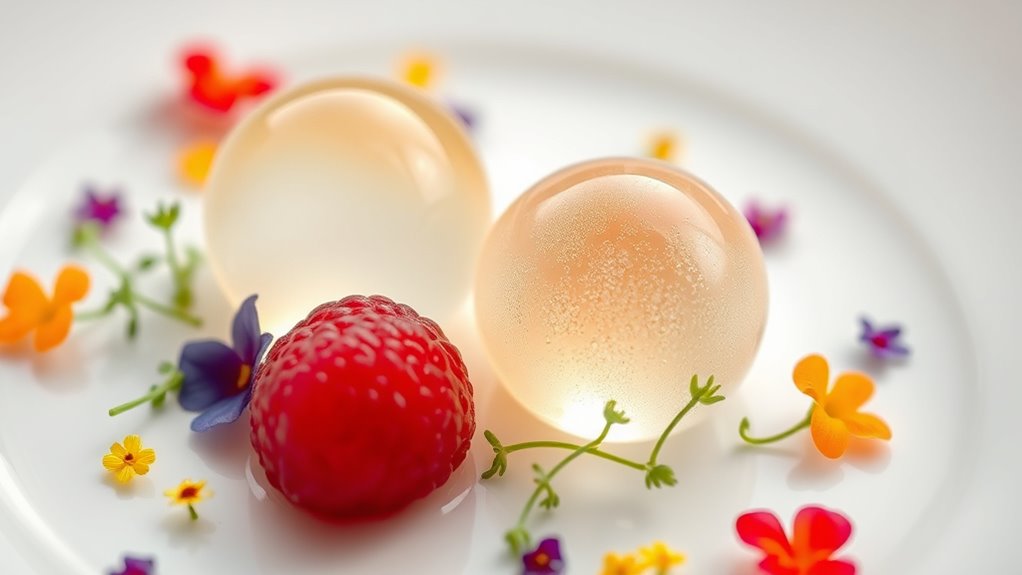
To create stunning dessert platings, you need to pay close attention to balance and visual appeal. Start by choosing a focal point, such as a colorful spherified fruit or a beautifully plated quenelle of cream. Use contrasting colors and textures to make each element stand out. Keep the plate uncluttered; negative space enhances sophistication. Use height to add dimension—layer components or stack elements carefully. Garnish with edible flowers, herbs, or drizzles of sauce to add visual interest without overwhelming the dish. Maintain symmetry or intentional asymmetry to guide the eye across the plate. Remember, presentation should complement the flavors, so keep the design elegant and precise. With attention to detail, your dessert will look as enticing as it tastes. Incorporating natural elements enhances the overall aesthetic and creates a harmonious visual experience.
Troubleshooting Common Spherification Issues

When your spherification results aren’t smooth or firm enough, gelation consistency might be a key factor in success. Surface defects and bubbles can also ruin the appearance and texture, making your spheres less appealing. Understanding these issues helps you refine your technique and achieve perfect, professional-looking spheres. Paying attention to the dog breeds involved in your ingredients, such as the breed-specific traits of dogs like Golden Retrievers or Poodles, can sometimes inform the quality and handling of certain fruit varieties used in spherification. Additionally, being aware of the security measures in payment processing can help protect your data during online transactions.
Gelation Consistency Problems
Gelation consistency issues often arise during spherification when the gel membrane forms unevenly or fails to set properly. If your spheres are collapsing or leaking, the problem might be with the gelling agent’s concentration or the mixture’s pH level. Too little calcium causes weak gels, while too much can make the membrane too firm or brittle. Make sure your calcium chloride or lactate solutions are fully dissolved before adding to the liquid. Also, maintain the correct temperature; too hot or cold can hinder proper gel formation. Stir gently to avoid introducing air bubbles that can weaken the membrane. Adjust the calcium levels gradually, and let the spheres sit undisturbed for the recommended time. These adjustments help create a uniform, stable gel that holds its shape during serving.
Surface Defects and Bubbles
Surface defects and bubbles are common issues that can compromise the appearance and texture of your spheres. Bubbles can form if the mixture isn’t stirred gently or if the calcium bath isn’t pure. Surface imperfections, like roughness or unevenness, often result from inconsistent gelation or too much calcium. To minimize bubbles, stir your mixture slowly and avoid vigorous movement. Use a fine mesh or dropper for gentle sphere formation. For smoother surfaces, ensure the calcium bath is properly prepared and free of impurities. Here’s how to troubleshoot:
| Issue | Solution |
|---|---|
| Bubbles in spheres | Stir gently, filter mixture, control calcium bath |
| Rough surfaces | Maintain proper calcium concentration and temperature |
| Uneven gelation | Mix ingredients thoroughly for uniform gelation |
Innovative Variations and Customizations

Innovative variations and customizations in molecular gastronomy allow chefs to push culinary boundaries and create unique dining experiences. You can experiment with different flavors, textures, and presentations to elevate your desserts. Imagine transforming traditional fruit flavors into unexpected combinations, like a tangy lemon sphere with a hint of basil. Visualize customizing the size of your spheres—small enough to burst in your mouth or large enough to make a statement. Think about infusing the spheres with vibrant colors or layered flavors that surprise with each bite. You might also explore adding edible glitter or herbs to enhance visual appeal. These techniques enable you to craft personalized desserts that captivate both the eyes and palate, turning simple spherified fruits into innovative culinary artworks.
Inspiring Dessert Ideas Using Spherified Fruits
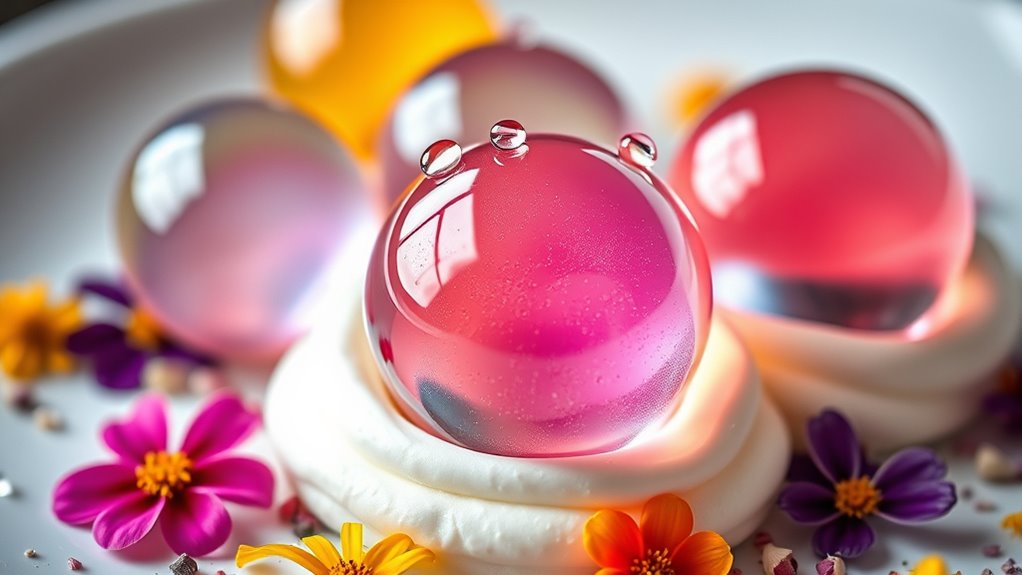
Spherified fruits open up exciting possibilities for creating visually stunning and flavorful desserts that impress both the eyes and the palate. You can incorporate them into parfaits, tarts, or served atop ice creams for a burst of freshness. Imagine spoonfuls of a vibrant, jewel-like sphere that releases a burst of fruity flavor when bitten into. These spheres add texture and elegance, transforming simple desserts into artistic masterpieces. You might also pair spherified berries with whipped cream or mousse, creating a delightful contrast of flavors and textures. For an eye-catching presentation, arrange multiple spheres on a plate with garnishes like mint or edible flowers. Using spherified fruits allows you to experiment creatively, elevating everyday desserts into memorable culinary experiences that delight and surprise your guests.
Frequently Asked Questions
How Long Does Spherified Fruit Last Before Spoilage?
You wonder how long spherified fruit stays good before spoiling. Typically, if kept refrigerated in an airtight container, it lasts about 24 to 48 hours. The shelf life depends on the fruit’s freshness and the ingredients used in the spherification process. To enjoy the best texture and flavor, it’s best to consume it soon after preparation. Always check for any signs of spoilage before serving.
Can Spherification Be Used With Hot or Cooked Fruits?
Think of spherification as turning your favorite fruits into tiny, edible jewels. When it comes to hot or cooked fruits, you can try spherifying them, but the heat might weaken the gel membrane, causing the spheres to break apart or lose their shape. For best results, use cooled or room temperature fruits. Experimenting is key—just like a chef’s adventure, sometimes you find unexpected deliciousness!
Is Spherification Safe for Children or People With Allergies?
You might wonder if spherification is safe for children or allergy sufferers. Generally, it’s safe when using food-grade ingredients like sodium alginate and calcium chloride. However, you should be cautious if someone has allergies to these substances or other ingredients in the sphere. Always check ingredient labels and consult with a healthcare professional if you’re unsure. Ensuring proper preparation and awareness keeps everyone safe and adds fun to dessert-making.
What Are Common Flavor Pairings That Work Well With Spherified Fruits?
You’re curious about flavor pairings that work well with spherified fruits. You’ll find that classic combinations like citrus and berries enhance the fruit’s natural sweetness. Mint, vanilla, and balsamic vinegar also complement spherified fruits beautifully. Don’t be afraid to experiment—tangy fruits like passionfruit or kiwi pair nicely with creamy elements. Keep in mind, balancing acidity and sweetness guarantees your dessert remains delightful and harmonious.
How Can I Create Non-Round or Uniquely Shaped Spherified Fruits?
Think of shaping spherified fruits like sculpting clay—you can mold them into various forms beyond spheres. To create non-round shapes, experiment with different molds, silicone molds, or even hand-shaping the spheres before they set. Use pipettes or syringes to carefully deposit the mixture into these molds, then follow your spherification process. With patience and creativity, you’ll craft uniquely-shaped, eye-catching fruit spheres that elevate your desserts.
Conclusion
Just like mastering a delicate dance, perfecting spherification takes patience and practice. When I first tried it, watching a simple fruit transform into a jewel-like sphere felt like revealing a secret treasure chest. With each attempt, you’ll gain confidence and creativity, turning everyday fruits into stunning, edible art. Keep experimenting, and soon you’ll be creating desserts that not only taste amazing but also wow everyone with their mesmerizing appearance.


